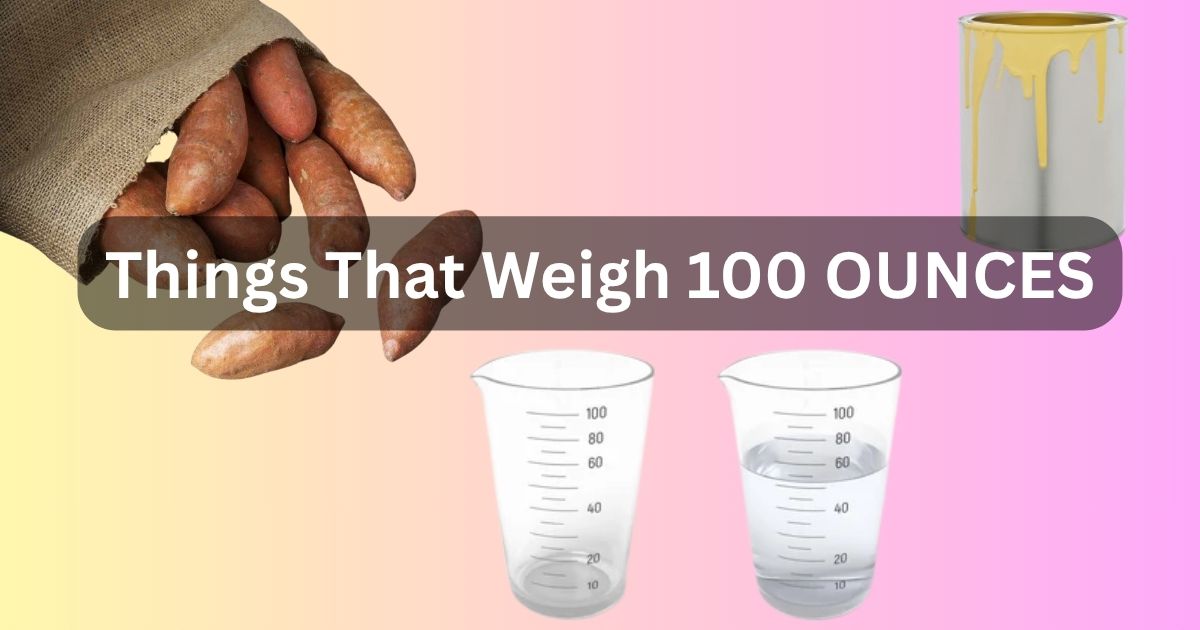Did you know that 100 ounces is equivalent to over six quarts? 100 oz is a measurement that often pops up in recipes, fitness goals, and even household products. This article aims to clarify what 100 ounces means and why it matters, especially in contexts like nutrition and cooking.
How Much is 100 Ounces?
In Kilograms, 100 ounces is equal to 2.84 kilograms approximately. This conversion is useful in culinary contexts, where precise measurements impact the outcome of a recipe.
For instance, if you’re measuring ingredients for baking, knowing that 100 ounces is nearly 2.84 kilograms ensures your cake rises perfectly.
In terms of volume, 100 ounces translates to about 2.96 liters. This measurement is significant when dealing with liquids.
These conversions aid in practical applications and also enhance our ability to communicate effectively across different measurement systems.

Things That Weigh About 100 Ounces
Let’s explore the 9 most common things from our daily life, that are exactly 100 ounces.
2 Cans of Paint
Two standard cans of paint, each weighing around 50 ounces, make a hefty total of 100 ounces. As you lift them by their sturdy handles, you can feel the weight in your arms—a tangible reminder of the work ahead.
With each brush stroke, you’re not just applying color; you’re infusing new life into tired walls, creating an atmosphere that reflects your style and personality.
12 Cups of Water
Twelve cups of water weigh nearly 100 ounces. Imagine a large pitcher, brimming with clear, refreshing liquid. This amount is equivalent to almost three-quarters of a gallon.
When you think about it, carrying around 12 cups of water also illustrates the effort required to maintain our health. It’s not just about quenching thirst; it’s about nourishing our bodies and supporting every function from digestion to circulation.
5 Large Sweet Potatoes
Five large sweet potatoes, weighing in at around 20 ounces each, collectively tip the scales at nearly 100 ounces. Imagine a small mound of these vibrant orange tubers, their earthy aroma wafting through the air as you carry them home from the grocery store.
Each potato, with its rugged skin and creamy interior, is a culinary delight and a nutritional powerhouse, packed with vitamins A and C, fiber, and antioxidants.
25 Sticks of Butter
Imagine a towering stack of 25 sticks of butter, each one wrapped in its signature gold foil and neatly arranged. This impressive collection weighs approximately 100 oz.
Butter is considered the heart of many recipes. It brings rich flavor and creamy texture to dishes, elevating everything from baked goods to savory sauces.
6 Large Oranges
Imagine a vibrant bowl filled to the brim with six large oranges. Each orange, typically weighing around 16 ounces, contributes to a collective weight of nearly 100 ounces. The scent of citrus fills the air as you reach for one, feeling its smooth surface and the slight give of its juicy flesh beneath your fingers.
As you lift the bowl, the weight becomes tangible—a hefty reminder of nature’s bounty. This pile of oranges not only represents a significant amount of fruit but also symbolizes nourishment and vitality.
30 Golf Balls
Imagine holding a small bag filled with 30 golf balls, each weighing about 1.6 ounces. Together, they come close to the magical threshold of 100 oz.
As you lift the bag, you can feel the solid presence of the balls, each one representing a moment on the green, a swing perfected, or a game won. The round shapes fit snugly in your palms, reminding you of sunlit afternoons spent chasing par.
2 Large Bags of Coffee (Each 3 Lbs)
Two large bags of coffee, each weighing 3 pounds, pack a punch that is hard to ignore. At approximately 48 ounces each, these hefty bags combine to tip the scale at nearly 100 ounces, making them a staple for any serious coffee enthusiast. The rich, earthy aroma wafts through the air as you unseal the bags. Each scoop offers not just caffeine but a moment of solace in a hectic day.
100 Quarters (coins)
Imagine a massive stack of 100 quarters. Each quarter weighs about 0.2 ounces so that hefty pile accumulates to a solid 20 ounces.
Multiply that by five, and you have a staggering amount of 100 ounces—an impressive weight that can easily make your hand sore if you attempt to carry it all at once.
1 Small Watermelon
Imagine cradling a small watermelon, its smooth, green rind reflecting the summer sun. Weighing in at about 96 ounces, this juicy fruit is just shy of the 100-ounce mark.
The weight is not just in its physical presence; it embodies the essence of summer picnics and backyard barbecues.
As you hold this medium-sized watermelon, you can sense its density—the way it seems to pulse with hydration and flavor. Its hefty size makes it a centerpiece for gatherings, inviting friends and family to gather around.
Conclusion
100 ounces equates to about 6.25 pounds. This measurement holds importance in numerous fields, from cooking to industrial applications.
From a gallon of water to a medium-sized laptop, there is a diverse range of objects that approximate this weight. Recognizing these common items helps us visualize and better comprehend what 100 ounces truly represents. Whether you are packing for a trip or simply curious about weights, knowing the equivalence of 100 ounces can enhance your practical knowledge.
FAQs
How Much is 100 Ounces in Liters?
One ounce is approximately equal to 0.0295735 liters. 100 ounces is equivalent to about 2.96 liters. This conversion is useful in various fields such as cooking, chemistry, and pharmaceuticals.
How Much is 100 Ounces in Gallons?
1 gallon is equivalent to 128 ounces. So, 100 ounces is approximately 0.78 gallons when rounded to two decimal places. This conversion is useful in various contexts, such as cooking or measuring liquids.

